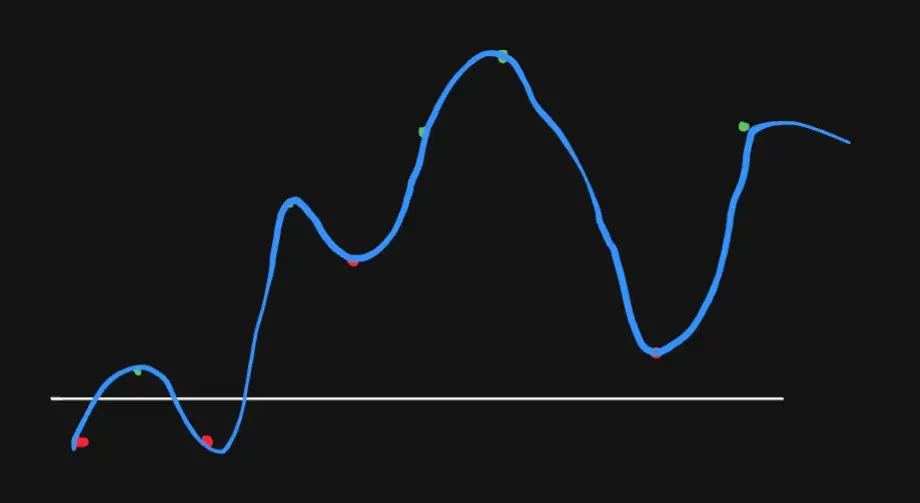Table of contents
Open Table of contents
The maximum subarray problem
I’ve recently decided to improve my coding skills by practicing regularly on Codewars, a coding challenge website similar to LeetCode. After some quite trivial problems, I stumbled upon an interesting one: the maximum subarray problem. Here’s its statement:
The maximum sum subarray problem consists in finding the maximum sum of a contiguous subsequence in an array or list of integers…
Let’s say you have an array of numbers just like this:
[-2, 1, -3, 4, -1, 2, 1, -5, 4]The maximum sum of a contiguous subsequence would be 6, because of the subarray composed of these values:
[4, -1, 2, 1] // indexes from 3 to 6 of the original arrayAlright, the problem statement was clear enough. But what about the solution? I’ve been looking to the sample arrays provided by the challenge for hours, and I really just couldn’t seem to find a smart, elegant way to find the maximum subarray — and I knew there was one, for sure.
To me, thinking about subarrays is like thinking about windows. A generalized solution must be able to find any slice, any range of indexes that when added together has the highest value compared to any other range.
The worst solution possible: comparing all the windows
After some hours thinking about windows I decided to put aside perfectionism and the expectation of finding a smart solution. I was blocked, and I just had to try if at least the worst solution I could imagine might have worked or not.
So here it is, my first solution: a really inefficient algorithm that checks all of the possible windows — every position and size — and keeps record of the maximum sum.
The first loop goes from the largest to the shortest span, or window “size”; the second loop “moves” the window “from left to right” and computes the relevant sums in each moment.
const sum = (arr) => arr.reduce((total, current) => total + current, 0)
const maxSequence = function(arr){
let start = 0;
let end = arr.length - 1
if (arr.length === 0 || arr.every((el) => el < 0)) return 0;
// From largest to shortest span, or "window size"
for (let span = end; span >= 0; span--) {
// Moving the current "window" from "left to right"
for (let offset = 0; offset < arr.length - span; offset++) {
const compareSequence = sum(arr.slice(start, end + 1));
const currentSequence = sum(arr.slice(offset, offset + span + 1));
if (currentSequence > compareSequence) {
start = offset;
end = offset + span;
}
}
}
return sum(arr.slice(start, end + 1));
}This solution happened to work. I was relieved, but not satisfied: I knew I had deliberately given my worst, and I was sure that if I ever decided to check the other practitioners’ solutions I would have been hit by heavy disappointment seeing one-liner solutions or something.
And this is exactly what happened, because on the next day I still couldn’t think of a better solution and I decided to have just one look to the first other practitioners’ solutions.
Measuring mountains: Kadane’s algorithm
There, I discovered two things: the challenge is a classic coding problem solved best by “Kadane’s algorithm”, and its implementation wasn’t more than 10 lines of JavaScript.
I still wanted to develop an own solution, so I just gave a quick glance so that the solution could serve me more as a hint. The only thing that stick to my mind was that there was only one loop, and a weird combination of Math.max() calls accomplishing something I couldn’t grasp.
After one more day I came up with something so simple that at first I couldn’t really believe that it would work:
const maxSequence = function(arr){
let currentSum = 0;
let maxSum = 0;
for (const num of arr) {
currentSum = Math.max(0, currentSum + num);
if (currentSum > maxSum) maxSum = currentSum;
}
return maxSum;
}The solution worked, and the reason is that the most useful way to imagine this problem — to understand Kadane’s algorithm — is thinking about mountains rather than windows.
The key idea is that, when sequentially adding numbers to build the maximum sum possible, all the previous contributions that cause it to sink below-zero don’t matter.

This drawing masterpiece tries to emulate the overall sum of the array in this post’s opening:
[-2, 1, -3, 4, -1, 2, 1, -5, 4]Red dots represent negative contributions, while greens are the positive ones. Only the positive sequences are meaningful to us, and they may look just like mountains.
- The most useful way to use this metaphor is to imagine walking on the curve from left to right, only starting to count when the level is above sea and keeping track of the highest peak that has been reached until the current iteration.
- Every time we are able to push the peak record higher, we know another useful positive integer has just entered our sequence.
- If we go back below zero, we know we clearly are not inside a positive and meaningful sequence, so we can reset our counter to zero.
- The highest peak marks the end of the maximum subarray, since the numbers after it cannot contribute enough to the goal.
I’ve also made an animated visualization hoping that it could help someone to understand the solution.